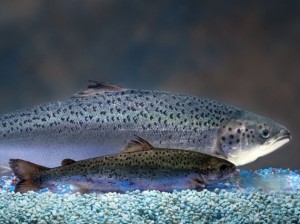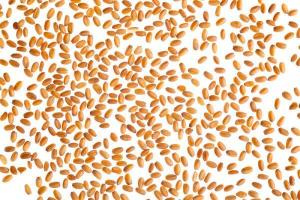Written by Rebecca Nesbit

Biotechnology in the fish farming industry hit the headlines in 2017 when a fast-growing salmon became the first GM animal to reach the market. In Europe, however, new developments in biotech’s potential for aquaculture went largely un-reported. Rather than focusing on the fish, British scientists are making progress towards creating fish food from a transgenic plant. For almost two decades, scientists from Rothamsted Research and their collaborators have been working towards providing oils for farmed fish from one of Europe’s oldest oilseed cropsLcamelina. The latest results bring them a step closer to realizing their vision.
Why focus on fish feed? To understand that we must think about where our fish and their nutrients come from.
The current problems with meeting our demand for fish
Over half of the fish we consume comes from farms, and aquaculture uses around 80% of the fish oil harvested annually from the sea. More fish goes into the system than comes out, which means that much of the fish caught from the wild goes to feeding farmed fish. Growing demand for omega-3 LC-PUFAs, particularly from aquaculture, has placed substantial pressure on the wild fisheries which supply much of this fish oil.

The root of the problem is that that fish oils aren’t produced by fish. Instead fish acquire them from microalgae, which aren’t available to caged fish in farms. We don’t currently have financially-viable technology to produce algae on a large scale, so farmed fish are fed oil and meal made from fish caught from the oceans. In this way, the fatty acids consumed by the smallest fish accumulate all the way up through the food web.
Vegetable oil can be used as an alternative to fish oil in feed, but this changes the nutritional value of the fish people eat. Given that fish can’t make their own fish oils, they can only accumulate these oils if they consume them as part of their diet. Now that farmed fish have more vegetable oil in their diets, they are no longer providing consumers with the same level of omega-3 and the associated health benefits.
Producing the appropriate oils from plants has the potential to ensure that farmed fish bring their full benefits for human health, whilst simultaneously reducing pressure on wild fish stocks.
Promising results from 2017

A new paper in Scientific Reports shows that their plants have the potential to yield oils in the field, and results published in the journal PLOS ONE showed that these oils are suitable food for salmon. The project, led by Professor Johnathan Napier, uses Camelina sativa (false flax), a distant relative of oilseed rape. Camelina is naturally high in short-chain omega-3, but it’s long-chain omega-3 that is important for fish food. To change the profile of oils in the seed, the team has introduced synthetic DNA sequences into the camelina genome. The introduced genes are similar to those found in marine microbes, and code for enzymes in the biochemical pathway which produces long-chain omega-3 polyunsaturated fatty acids (LC-PUFAs).
The oil can be extracted from the seed and fed to fish, and that is exactly what happened in the feeding trial reported in PLOS ONE. The newly-published data show results from a 2015 field trial of GM camelina, and confirm positive findings from 2014.
Firstly, results from both years show that the transgenic plants perform well in the field. The studies went beyond agronomic performance, as they also examined the composition, or profile, of the oil produced by the plant.
The profile of seed oil has also been improved relative to earlier varieties of transgenic camelina. Not only were the scientists looking to increase the concentration of desirable fatty acids, they were also keen to reduce the production of some of camelina’s natural oils. Omega-6 fatty acids are only present in low levels in marine organisms, so the latest varieties have been engineered to produce smaller quantities.
Salmon feeding trials have also seen positive results, and oil from GM camelina was an effective substitute for fish oil in feeds, supporting growth without compromising fish health. The fish accumulated fatty acids exactly as they would when fed oil from fish, creating a fish with the desired health benefits for consumers.
Trials on sea bream have also indicated that GM-derived oils could replace fish oils in their diets.
The future of camelina
The results published in 2017 indicate that oils from transgenic plants offer the opportunity to increase the levels of omega-3 LC-PUFAs in farmed fish to levels found a decade ago. Further development work is now taking place to make this a reality on a large scale.
The next steps for the project is to select the best camelina lines – i.e. those producing the highest levels of omega-3 fish oils. These plants will be used in larger field trials to demonstrate that they perform as well in the field as they do in the glasshouse.

The work will then need to move from the research phase to development and commercialization. As well as planning how to make the crop available on a commercial scale, an essential step will be seeking regulatory approval. Although the research has been done in the UK, the status of the EU regulatory system means that the team will be applying for approvals outside of Europe.
Issues to be addressed before the plants are suitable for regulatory approval include freedom-to-operate (ensuring that no patents would be infringed if the crop is commercialized), and appropriate farm management. Camelina is predominantly self-pollinated but is visited by insects, so during the trials scientists addressed concerns from local beekeepers by covering the flowering crop with a fine mesh net to prevent bees from transporting GM pollen back to their hives. Such measures wouldn’t be feasible if the crop was grown on a commercial scale, but the team is considering the farm management practices which would be needed to prevent gene flow. Thankfully, camelina doesn’t cross pollinate with oilseed rape or other Brassica species, making large-scale planting more feasible without risking cross-pollination of other crops. In the end, to goal is to make aquaculture more environmentally sustainable while maintaining the healthy properties of the fish that we eat.
For updates on the project and more background reading, please visit the Rothamsted website. I also cover the topic in my book Is that Fish in Your Tomato?
Written by Guest Expert
Rebecca Nesbit is author of the popular science book ‘Is that Fish in your Tomato?’ which explores the fact and fiction of GM foods. She studied butterfly migration for her PhD, then worked for a start-up company training honeybees to detect explosives. She now works in science communication and her projects have ranged from a citizen science flying ant survey to visiting universities around the world with Nobel Laureates. In her spare time she writes fiction – she has published a novel, and many short stories.
Great–I hope we can use it to reduce harvesting wild fish in two ways: feed it to the tank-grown GMO salmon. SeafoodWatch calls recirculating tanks a “best choice” and has an environmental report on those systems. But it would be even more helpful to have faster-growing fish that need fewer other fish as food. I can’t wait until they calculate all of that and see which is the better “best choice”.
LikeLike
Can’t wait??? Many of us expected you to do the calculations. So disappointed.
LikeLike